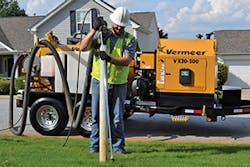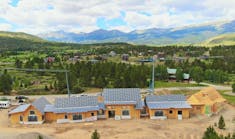Hydro excavation is the manner of removing earth through the use of water. The most popular machine in hydro excavation is the vacuum truck. Vacuum trucks are becoming more popular as their applications become more diverse.
Hydro excavation gets used in diverse applications, such as exposing utilities, safety for daylighting, trenching, putting in lines, and environmental cleanups, as well as for cleaning up the mess when a water main gets hit.
According to Jake Jeffords, director of sales and marketing for McLaughlin Underground, the increasing number of buried utilities that occupy the rights-of-way of city streets is the driving force behind the expanded use of vacuum excavators. “Before digging for a new utility line, a call must be placed to 811/One Call so existing utilities can be marked,” he explains. “However, on almost every utility job, the contractor must expose any buried lines that a new installation may cross to help avoid unknowingly striking an existing utility, and using a vacuum excavator is an efficient and nondestructive way to do that.”
“Hydro excavation equipment is versatile; it is typically used when locating utilities underground, but it can also be used for minor clean up, potholing, and on large excavation jobs,” says Chapman Hancock, Ditch Witch product manager, vacuum excavators. “These vacs are often used to verify the location of underground utilities. Cities, utility owners, energy companies hire our customers to locate a line that was just installed to make sure it is exactly where they say it is for mapping purposes.”
“Hydro excavation is generally used for utility locating and potholing/daylighting,” says Charles Bell, sales manager, VacMaster. “Potholing is commonly used in the industry for exposing a utility where there will be future mechanical excavation work. It’s different from lidar systems in that you get actual eyes on.”
The Ditchi Witch HX50, HX75, and HX30 are equipped with Kubota Tier 4 Final engines that have greater fuel capacity than their predecessors and boost power and dampen noise.
When it comes to utility detection, hydro excavation allows for the most accuracy, since you get to see it—and not just an image of it based on a screen—with the least amount of intrusion, since you remove less earth and the dig site has a smaller work footprint than a dig site that employs mechanical engineering.
“The growth in vacuum excavation is largely due to the increased focus on preventing utility strikes and improving job site safety. There’s a tremendous risk of injury and expense associated with power/service outages, burst water lines, gas explosions and damaged property that can result when a buried utility is struck during mechanical excavation,” says Nick Bruhn, product manager, Vactor Manufacturing. “Vacuum excavation increases worksite safety and decreases the cost of digging by minimizing the risk of utility strikes.”
“Fiber optics is an opportunity that we are looking into in order to expand our product reach,” says Mike Reiss, vice president of sales, Super Products. “We estimate that only 25% of the country has fiber optics installed. Where fiber is being laid continues to grow each day. So, the challenge with those companies is I want to dig more holes and stay on the job site longer, but I have to find the utilities before I can lay any new cable.”
Vacuum trucks are an ever-expanding niche and they have some capabilities that can’t be duplicated by other machines, but in some applications, a downhole pump may be a better option. “If the project involves removal from submerged, wet conditions, US Submergent Technologies is the only cost-effective option in the marketplace,” says Denver Stutler, Jr., CEO, US Submergent Technologies (USST). The company developed the Combination3 Truck to function as a standalone cleaning system powerful and versatile enough to remove accumulated sand, grit, and rag material from a variety of submerged conditions.
“At the most basic level, hydro excavation equipment and vacuum trucks are used to move material from one place to another,” says Stutler. “USST specializes in the removal of material from submerged conditions, utilizing our patented Combination3 truck, which houses a jetter, vacuum, downhole pump, and a 49-foot knuckleboom fully integrated on one chassis.” USST focuses on submergent cleaning from hard-to-reach environments and provides services for restoring the capacity of wet infrastructure.
Jobsite Challenges and Technological Solutions
“There are several factors to consider when choosing which machines to use. Will the cleaning take place in a wet condition? If the structure to be cleaned is full of water, then a submersible system is the only way to efficiently remove large quantities of material. And, what is the depth and composition of the material? Vacuum technology can only move material up a certain height, and if that material is a heavier solid such as sand, then that further limits its capabilities,” says Stutler.
The space in which the machine operates can be a challenge. Not all job sites are accommodating to large trucks with long booms. “Job-site footprint is one of the things that was front of mind when we came out with the HX line; we made sure it was more compact and capable of getting in and out of those jobs.” The overall width and height of the HX line are decreased. “The overall height of the machines is lowered by 10 inches, so they can access height-restricted areas,” says Hancock. “And the ground clearance is increased by five inches, so they can traverse rough terrain and go up curbs, and we reduced the overall width to have a smaller footprint.
Ditch Witch offers a variety of vacuum excavators to suit the variety of projects on which these machines get used. They have an offering of truck vacs, which include the FXT50 and FXT65. Their entry-level FX20 and FX25 vacs are designed for smaller potholing jobs, while their MV800 is catered more to the HDD (horizontal directional drilling) industry since it is well-suited to mud disposal. The company also just released a new line of trailer vacuums: HX30, HX50, and HX75 that are available in 500- and 800-gallon configurations.
“Operator safety is always front of mind in our machine designs as well. The controls are located on the rear of the unit, so the operator has visibility of all the moving parts on the rear, so when the door is opening or the tank is tilting, they can see and know that it is a safe time to operate those controls,” says Hancock. “They also feature a new door design, which locks the door in an open position and won’t shut without hydraulic input.”
According to Jeffords, vacuum excavators with a 3-inch diameter suction hose are the most popular size for utility potholing work. “Units with this size hose tend to be on the smaller size of the vacuum excavator models but pack plenty of suction force,” he adds. “Of course, one unit isn’t the right choice for everyone, which is why McLaughlin offers several different options in the three-inch hose category. We carry gas and diesel trailer-mounted units, as well as fuel efficient truck-mounted systems. Users can also choose between spoil tanks ranging from 300 to 3,000 gallons in size.”
When using water, one of the major challenges is finding a place to unload the material. When you use water to suck up dirt, you get mud. You usually can’t dump it on site; you have to find a fill or some other location where it can be placed to dry out. Working at a proper weight can be a challenge. You want to increase your productivity by making fewer dumps, but you can’t exceed road weight restrictions. The third challenge is access to job sites. How can you maneuver the machine into a tight area in order to do the work?
“We have done our best to lighten the truck to get maximum payload. We have a controlled dump; we are the only ones using an ejector plate system with only a 20-percent angle, you’re your dump, so you can stop the dump at any time with our machines. We can control our dumping area.
“We try to make the truck as compact as possible for maneuverability. On top of that, we now have the longest boom in the industry. The truck provides a 27-foot reach boom with a 14-foot digging depth. This means you can park the truck curbside and still reach over the sidewalk and be able to dig and not have to jump up and over obstacles to get there.”
Some facilities or cities may have a mandate one way or another. You get a higher production with water than with air. Some are concerned about the mess that is associated with water, so they choose air.
Mike Tonies, the industrial sales manager for HydraFlex Inc., says, “I will center the conversation around cost. Hydro excavation contractors rely heavily on water, so one of their biggest challenges is to be able to go through their jobs in a day without wasting water. The second challenge is finding access to dump sites. Once your truck fills up with the slurry or spoils that have been vacuumed up, you have to find a dump location. How far is the dump site from your job sites? How much do they charge? What is the cost of fuel? So, the biggest challenges all center around the cost of operating the business, and we help them mitigate those costs the best we can.”
Tonies adds, “We help our customers through specific design elements of our products. We want to help them reduce the water consumption on each job, so you can complete more jobs in a day. You are intaking more soil than water and that translates the debris tank getting filled at a slower rate, thereby reducing the number of trips to the dump site, which means you can save on fuel costs and dump charges. For us, it’s about eliminating waste—waste of water and waste of time and waste of money. We introduced our equipment because we believe it is a unique opportunity to put in a new business model from a cost standpoint for vacuum excavation and trenching contractors.”
“Unlike vacuum, there is virtually no functional depth or height restrictions to the removal capabilities of USST’s downhole pump system. No additional equipment, machinery, or tools are needed to be brought in, saving time and resources for the client. USST’s technology also has the capability to clean in submerged conditions while facilities remain fully online,” says Stutler.
Case Studies
1. Customization needed to prevent damaging road infrastructure: One Ditch Witch customer was tasked with a job that involved crossing a major highway. In order to locate it, they had to be on both sides of the highway and they had two major lines going through.“Keep in mind a typical potholing application is six inches in diameter and four to eight feet deep,” says Hancock. “This contractor potholed 17 feet deep in multiple areas in order to locate the line, so they were able to take their Ditch Witch vacuum and, with the help of Ditch Witch, modify the tool so it could accept extensions that would allow the machine to go down 17 feet deep, suck out the material, confirm where the utilities ran, map them, and return a plot to the company so they knew the exact location of the lines.”
2. Improper excavation increases disruption: Here is a story from the perspective of an energy company and it shows how increased construction activity can lead to greater line strikes.Énergir is the principal natural gas provider for the province of Quebec, Canada. Company spokesperson David Laureti says the increase in line breaks in Montreal is probably due to the greater number of crews performing work in the city.
Besides the increase in construction activity, the number of line breaks is up 15% compared to the same period last year. And, Laureti also stated that 57% of gas line breaks occur as a result of improper excavation and in one-third of the cases, no one called for a locate.
Gas line breaks rarely have serious consequences, but one rupture in the province of Quebec caused 12,000 customers to go without power. “Obviously we would like to cut down on the number of breaks,” says Laureti.
The city of Montreal is working on new rules that require contractors performing work for the city to have an underground map of infrastructure.
3. A case stands against hydro excavation? The use of hydro excavation is causing a stir in the city of Flint, MI. The city is in the process of replacing thousands of damaged lead and galvanized water service lines on residential properties that were damaged by corrosive Flint River water. The lines have absorbed lead particles, which they could release into the water.Since the city has incomplete and inaccurate records, they turned to hydro excavation to identify which lines need replacement and which can remain.
However, after using hydro excavation to excavate thousands of properties, the mayor of Flint has put a stop to hydro excavation and is championing traditional excavation, stating that some lines that have been identified as copper were misidentified.
When Flint Mayor Karen Weaver learned about it, she put a stop to hydro excavation, stating that they were playing “Russian Roulette with some people.” Weaver then turned over the location of six addresses where she has said hydro excavation missed lines with lead or galvanized material.
According to Weaver, the boreholes created by hydro excavation are insufficient because some lines that were identified as one metal at the borehole were shown to be built of different materials in other sections of the line. So, the city started requiring contractors to use mechanical excavation to uncover 10 feet of each line.
When the city paid two contractors to excavate homes using mechanical excavation, the state of Michigan openly questioned the spending. It noted the average cost of mechanical excavation of a home is $1,660 compared to $228 for hydro-excavation.
The Michigan Department of Environment Quality (DEQ) Drinking Water and Municipal Assistance Division Director Eric Oswald advised Weaver her decision could add an additional $14.6 million in unnecessary expenses.
The fight between the city and the state over which excavation method is best was publicly debated.
“The DEQ supports and encourages the use of hydro-excavation for service line composition verification and replacement,” said DEQ spokeswoman Tiffany Brown. “When executed properly, the DEQ believes hydro-excavation is an extremely effective and reliable method of identifying service line composition.”
Conclusion “Hydro excavation is the safest way to dig—bottom line. If you hit a gas line with a backhoe—boom,” says Reis. “It does dig a little slower but, at the end of the day, all it takes is one line strike from water to electrical to fiber optics, and it can costs anywhere from thousands to millions of dollars for repairs, for downtime, for anything. It’s the only way for digging around known utilities. Why risk digging with a backhoe or a shovel, when you can fully expose it and then start digging. And if you don’t know what’s around there, it’s the only way to go, because why would you risk hitting something.”





